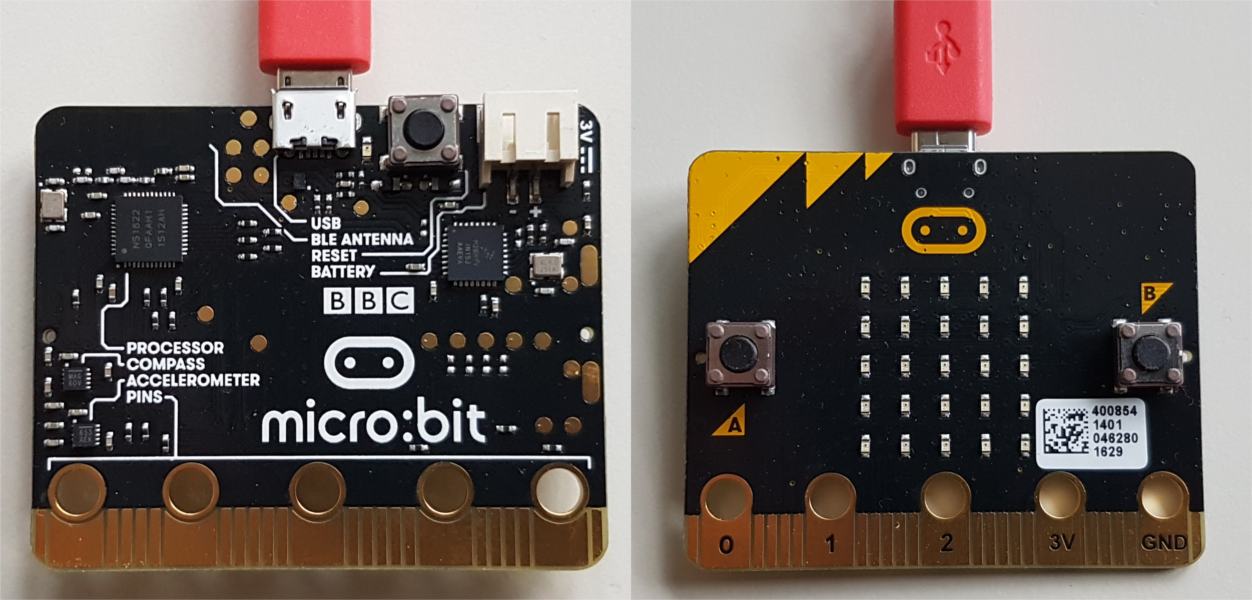mirror of
https://github.com/RIOT-OS/RIOT.git
synced 2025-01-18 12:52:44 +01:00
100 lines
3.3 KiB
Plaintext
100 lines
3.3 KiB
Plaintext
/**
|
|
@defgroup boards_microbit BBC micro:bit
|
|
@ingroup boards
|
|
@brief Support for the BBC micro:bit
|
|
|
|
## Overview
|
|
|
|
The [micro:bit](https://www.microbit.co.uk/) was designed by the BBC and
|
|
released in 2015. The boards was distributed to all 11-12 year old children
|
|
throughout the UK.
|
|
|
|
The board is based on the Nordic nRF51822 SoC, featuring 16Kb of RAM, 256Kb
|
|
of ROM, and a 2.4GHz radio, that supports Bluetooth Low Energy (BLE) as well as
|
|
a Nordic proprietary radio mode.
|
|
|
|
Additionally the boards features 2 buttons, a 5x5 LED matrix, a MAG3110
|
|
3-axis magnetometer, and a MMA8653 3-axis accelerometer.
|
|
|
|
|
|
## Hardware
|
|
|
|

|
|
|
|
| MCU | NRF51822QFAA |
|
|
|:------------- |:--------------------- |
|
|
| Family | ARM Cortex-M0 |
|
|
| Vendor | Nordic Semiconductor |
|
|
| RAM | 16Kb |
|
|
| Flash | 256Kb |
|
|
| Frequency | 16MHz |
|
|
| FPU | no |
|
|
| Timers | 3 (2x 16-bit, 1x 32-bit [TIMER0]) |
|
|
| ADCs | 1x 10-bit (8 channels) |
|
|
| UARTs | 1 |
|
|
| SPIs | 2 |
|
|
| I2Cs | 2 |
|
|
| Vcc | 1.8V - 3.6V |
|
|
| Reference Manual | [Reference Manual](http://infocenter.nordicsemi.com/pdf/nRF51_RM_v3.0.pdf) |
|
|
|
|
|
|
## Flashing and Debugging
|
|
|
|
There are two possibilities to flash the board: using the default ARM DAPLink
|
|
or you can flash the board using Segger's JLink.
|
|
|
|
### DAPLink
|
|
|
|
The [DAPLink interface](https://www.mbed.com/en/development/hardware/prototyping-production/daplink/daplink-on-kl26z/) is the default way to flash the board and
|
|
works out of the box. When you plug the board to your host computer, it shows up
|
|
as a flash drive. To flash the board, you can simply copy your compiled `.hex`
|
|
file onto the board, and thats it.
|
|
|
|
The `micro:bit` port comes with a little script that does this automatically,
|
|
so you can flash the board as usual with
|
|
```
|
|
bash
|
|
make flash
|
|
```
|
|
|
|
The DAPLink interface provides however not means for debugging the board.
|
|
|
|
### JLink
|
|
|
|
Recently, Segger released a JLink firmware for the interface MCU on the
|
|
`micro:bit`. You have to follow [these instructions](https://www.segger.com/bbc-micro-bit.html) to flash the JLink firmware on your `micro:bit`. Don't worry,
|
|
the process is very simple and you can revert the firmware back to the DAPLink
|
|
default anytime ([as described here](https://www.mbed.com/en/development/hardware/prototyping-production/daplink/daplink-on-kl26z/)).
|
|
|
|
Once you have flashed the JLink firmware, you can flash the board like this:
|
|
```
|
|
bash
|
|
FLASHTOOL=jlink make flash
|
|
```
|
|
|
|
With the JLink firmware, you can now also do in-circuit debugging etc.
|
|
|
|
**Note: The current version of the JLink firmware
|
|
(JLink_OB_BBC_microbit_16-07-29.hex) does not support any serial port over USB,
|
|
so you can not use the RIOT shell with this firmware.**
|
|
|
|
|
|
### QEMU emulation
|
|
|
|
The microbit can be partly emulated by QEMU.
|
|
|
|
This requires at least QEMU 4.0 with ARM platform support enabled.
|
|
|
|
*NOTE*: not all peripherals are emulated. See
|
|
[this](https://wiki.qemu.org/Features/MicroBit) page for an overview.
|
|
E.g., there's no emulation for the radio, thus applications using that will
|
|
fail.
|
|
|
|
Use it like this:
|
|
|
|
$ cd examples/hello-world
|
|
$ BOARD=microbit make clean all -j4
|
|
$ BOARD=microbit make emulate
|
|
|
|
*/
|